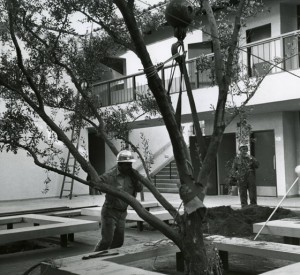Olive trees are a part of Scripps College’s DNA — from the very beginning of the College’s formation in 1926, olive trees have graced the campus. In fact, there is a courtyard bearing the fruit’s nomen: Olive Court, on the southeast side of Grace Clark Hall, was named for the fine olive tree that shades one corner.
 In the early 1930s, the College’s Cutting Garden and Olive Grove were planted on what is now home to Elm Tree Lawn and the Bette Cree Edwards Humanities Building. Over the years, trees were removed to allow for campus expansion; in 1966, the small olive grove between Grace Scripps Clark Hall and Denison Library was removed for construction of the Dorothy M. Drake Wing.
In the early 1930s, the College’s Cutting Garden and Olive Grove were planted on what is now home to Elm Tree Lawn and the Bette Cree Edwards Humanities Building. Over the years, trees were removed to allow for campus expansion; in 1966, the small olive grove between Grace Scripps Clark Hall and Denison Library was removed for construction of the Dorothy M. Drake Wing.
During the tumultuous ’60s, social activism was alive and well on college campuses, and Scripps students and alumnae embraced the movement. When the decision was made to construct the Humanities Building on its current site, many in the Scripps community protested the proposed destruction of the gardens, especially Olive Grove. In May 1968, students staged a protest and “took to the trees,” refusing to allow the trees to be cut down. It was such a heated issue that the campus landscape architect, Edward Huntsman-Trout, weighed in on the controversy, explaining in a letter to then-President Mark Curtis that Olive Grove had been planted as a “place saver” until needed as a building site.
The students refused to give in, resulting in a compromise: 60 trees were carefully dug up, boxed, and stored during construction of the Humanities Building, for eventual replanting in the court named for Dorothy Stauffer Lyddon ’44 and in areas north and south of the building.
 Fast forward to 2007, and a new Core II course taught by food-justice champion Professor Nancy Neiman, “The Politics and Culture of Food.” Professor Neiman asked her class to choose an aspect of the Scripps community that needed improvement from a sustainability standpoint. One group organized a public “fruit jam”, using the bounty of Scripps’ edible landscape, and another chose to investigate the possibility of producing olive oil from the remaining olive trees on campus.
Fast forward to 2007, and a new Core II course taught by food-justice champion Professor Nancy Neiman, “The Politics and Culture of Food.” Professor Neiman asked her class to choose an aspect of the Scripps community that needed improvement from a sustainability standpoint. One group organized a public “fruit jam”, using the bounty of Scripps’ edible landscape, and another chose to investigate the possibility of producing olive oil from the remaining olive trees on campus.
From that course, and the students it inspired, came a new movement on campus to utilize the olives and other edible plants on campus as a food source and further the College’s sustainability efforts. On November 9, 2012, dozens of students, staff, and faculty members gathered around the olive trees bordering the north and south walkways of the Humanities Building. The olives were at their peak, ready to be harvested. The simple act of “threading through the branches” for the olives involved teamwork, conversation, laughter, and community building. The following day, some students from Professor Neiman’s class and a few staff members drove the more than 1,500 pounds of olives to Ojai, where they were processed into olive oil. Described by the olive press owner as “fruity, buttery, and smooth, with a good bite and an olive note,” the Scripps olive oil was born, with more than 700 8-oz. bottles produced from that single day of harvesting. The bottles were offered for sale to the Scripps community and, to date, sales have covered all production costs.
Long renowned for its stunning landscape, Scripps College is entering a new era where the campus is not only beautiful, but bountiful, and more sustainable than ever. The Olive Oil Project is the culmination of faculty, student, and staff efforts to turn Scripps’ edible landscape into a virtual classroom for hands-on learning and embrace an ethic of sustainability. This project would not have been possible without the support of Lola Trafecanty and her staff in the Grounds Department.
